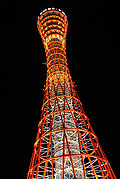Portal:Architecture/Selected article/2007-22
Hyperboloid structures in architecture were first applied by Russian engineer Vladimir Shukhov (1853-1939). In the 1880s, Shukhov began to work on the problem of the design of roof systems to use a minimum of materials, time and labor. His calculations were most likely derived from mathematician Pafnuty Chebyshev’s work on the theory of best approximations of functions. Shukhov’s mathematical explorations of efficient roof structures led to his invention of a new system that was innovative both structurally and spatially. By applying his analytical skills to the doubly-curved surfaces Nikolai Lobachevsky named "hyperbolic," Shukhov derived a family of equations that led to new structural and constructional systems, known as hyperboloids of revolution and hyperbolic paraboloids.
The hyperboloid roofs of the exhibition pavilions of the 1896 All-Russian Industrial and Handicrafts Exposition in Nizhny Novgorod were the first publicly prominent examples of Shukhov’s new system. The roofs of these pavilions were doubly-curved surfaces formed entirely of a lattice of straight angle-iron and flat iron bars. Shukhov himself called them “metal lace.” The patent of this system, for which Shukhov applied in 1895, was awarded in 1899. (more......)

